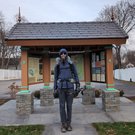Solar farms are not temporary
To the Editor:
I’d like first to commend you, Melissa Hale-Spencer and Elizabeth Floyd Mair and Sean Mulkerrin, for the consistently excellent editorials and reporting published in The Altamont Enterprise. I’d also like to commend James Gaughan and Jeff Perlee for their extensive comments, reminding us of the treasure the Helderberg escarpment and its viewsheds from above and below are. The Altamont Enterprise’s influence on our mutual sense of community is priceless.
With regard to Sean’s recent article, “Solar Rises,” explaining and bringing to our attention the “governor’s back-door plan” hidden in his budget proposal as the Accelerated Renewable Energy Growth and Community Benefit Act ostensibly to facilitate accelerated implementation of Climate Leadership and Community Protection Act to set aside the legal and historical local/home rule tradition assigning land-use decisions to counties, cities, towns, and villages, by the constitution and the Municipal Home Rule Law:
The plan would transfer the authority from local/home rule to a newly created State Office of Renewable Energy Permitting, which will replace local/home rule authority as it applies to solar and wind installations [of 25 megawatts or more; projects between 10 and 25 megawatts can opt in to the process].
The potential usurpation by the state is occurring at the time the town of Guilderland is debating amendments to its local law dealing with updating the town’s local/home rule zoning code as it relates to solar farms as described in Elizabeth Floyd Mair’s excellent article, “Guilderland looks set to protect important views.”
This letter to the editor, in context of the need to block the governor’s back-door plan to remove towns and their residents from applying criteria established by comprehensive plans and referenced publications to determine where solar farms and perhaps wind turbines might possibly be located in support of the governor’s renewable energy goals in its amended zoning code is to raise an important probability of the long-term change to our town’s environment and viewsheds.
I think it is misleading to refer to the solar farms that may be built in Guilderland as “temporary”; implying that, after the term of the lease has expired in 20 to 30 years, the solar farm will be dismantled and the acreage will return to its natural state.
It seems to me that, as a producer of renewable energy, something that justified the solar farm’s listed purpose to be constructed, the lease option will either be renewed or sold.
When the 30- or 40-year shingles on the roof of a house need to be replaced, the house underneath them isn’t torn down. Similarly, when the useful service of solar panels ends, it seems to me that, since the infrastructure supporting them and connecting them to an electrical grid, like the house underneath roof shingles, will continue to be sound, and the need for the solar power once produced continues, the zoning code will consider continuance of a solar farm at the location to be a pre-existing condition.
No further lengthy application and approval process will be required. The zoning code purpose will encourage the solar panels being replaced (probably with less expensive and more efficient solar panels at that).
After 20 to 30 years, the visual buffering will also have matured to maximum effectiveness. Residents affected (perhaps negatively) by the end of the lease term will have adjusted to having a solar farm as a neighbor, or will have moved away or passed away or have moved into the neighborhood understanding that it includes a solar farm.
Additionally, by continuing the productivity of the solar farm, pressures to replace it with another solar farm in a new location will fail to emerge.
To be honest, it needs to be clear to the residents of Guilderland that there will always be a solar farm in every location where one is permitted to be built. They will not be temporary. Selecting aesthetic locations now is critically important.
Charles Klaer
Guilderland
